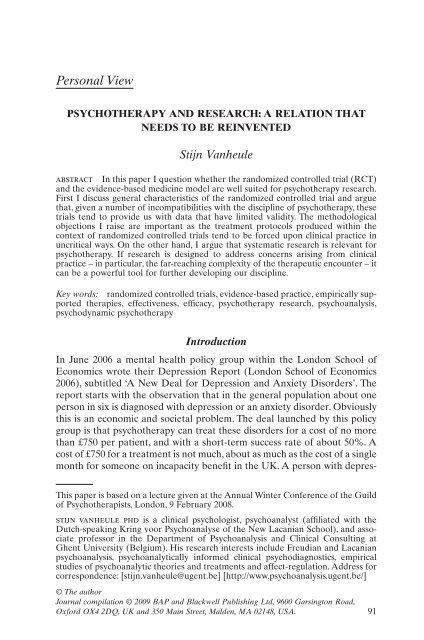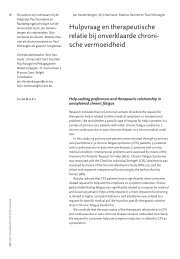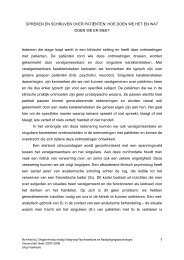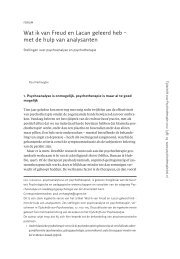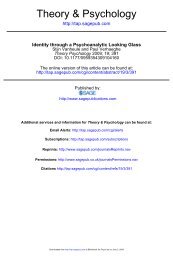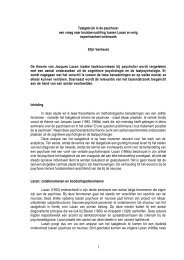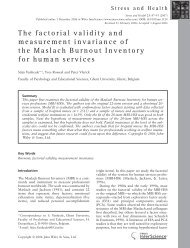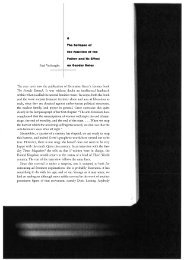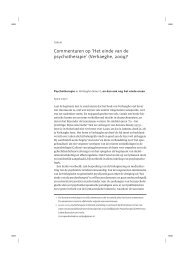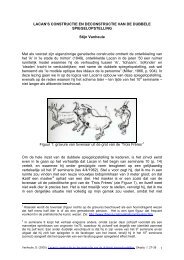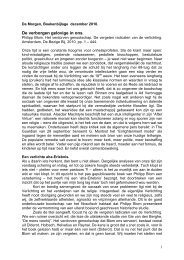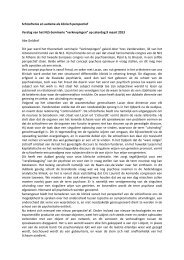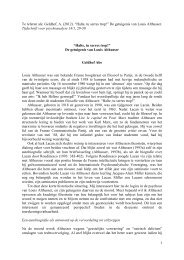psychotherapy and research
psychotherapy and research
psychotherapy and research
Create successful ePaper yourself
Turn your PDF publications into a flip-book with our unique Google optimized e-Paper software.
Personal ViewPSYCHOTHERAPY AND RESEARCH: A RELATION THATNEEDS TO BE REINVENTEDStijn Vanheuleabstract In this paper I question whether the r<strong>and</strong>omized controlled trial (RCT)<strong>and</strong> the evidence-based medicine model are well suited for <strong>psychotherapy</strong> <strong>research</strong>.First I discuss general characteristics of the r<strong>and</strong>omized controlled trial <strong>and</strong> arguethat, given a number of incompatibilities with the discipline of <strong>psychotherapy</strong>, thesetrials tend to provide us with data that have limited validity. The methodologicalobjections I raise are important as the treatment protocols produced within thecontext of r<strong>and</strong>omized controlled trials tend to be forced upon clinical practice inuncritical ways. On the other h<strong>and</strong>, I argue that systematic <strong>research</strong> is relevant for<strong>psychotherapy</strong>. If <strong>research</strong> is designed to address concerns arising from clinicalpractice – in particular, the far-reaching complexity of the therapeutic encounter – itcan be a powerful tool for further developing our discipline.Key words: r<strong>and</strong>omized controlled trials, evidence-based practice, empirically supportedtherapies, effectiveness, efficacy, <strong>psychotherapy</strong> <strong>research</strong>, psychoanalysis,psychodynamic <strong>psychotherapy</strong>IntroductionIn June 2006 a mental health policy group within the London School ofEconomics wrote their Depression Report (London School of Economics2006), subtitled ‘A New Deal for Depression <strong>and</strong> Anxiety Disorders’. Thereport starts with the observation that in the general population about oneperson in six is diagnosed with depression or an anxiety disorder. Obviouslythis is an economic <strong>and</strong> societal problem. The deal launched by this policygroup is that <strong>psychotherapy</strong> can treat these disorders for a cost of no morethan £750 per patient, <strong>and</strong> with a short-term success rate of about 50%. Acost of £750 for a treatment is not much, about as much as the cost of a singlemonth for someone on incapacity benefit in the UK. A person with depres-This paper is based on a lecture given at the Annual Winter Conference of the Guildof Psychotherapists, London, 9 February 2008.stijn vanheule phd is a clinical psychologist, psychoanalyst (affiliated with theDutch-speaking Kring voor Psychoanalyse of the New Lacanian School), <strong>and</strong> associateprofessor in the Department of Psychoanalysis <strong>and</strong> Clinical Consulting atGhent University (Belgium). His <strong>research</strong> interests include Freudian <strong>and</strong> Lacanianpsychoanalysis, psychoanalytically informed clinical psychodiagnostics, empiricalstudies of psychoanalytic theories <strong>and</strong> treatments <strong>and</strong> affect-regulation. Address forcorrespondence: [stijn.vanheule@ugent.be] [http://www.psychoanalysis.ugent.be/]© The authorJournal compilation © 2009 BAP <strong>and</strong> Blackwell Publishing Ltd, 9600 Garsington Road,Oxford OX4 2DQ, UK <strong>and</strong> 350 Main Street, Malden, MA 02148, USA. 91
92 BRITISH JOURNAL OF PSYCHOTHERAPY (2009) 25(1)sion <strong>and</strong>/or anxiety is also economically less productive. In the UK, the totalloss of economic output due to depression <strong>and</strong> chronic anxiety is estimatedat £12 billion per year – 1% of the total national income – while the cost ofa proper therapy service would only be £0.6 billion per year. Moreover, theauthors of the report agree that in the long run <strong>psychotherapy</strong> is moreeffective than drug treatment of depression <strong>and</strong> anxiety.However, the type of <strong>psychotherapy</strong> suggested <strong>and</strong> preferred in theDepression Report of the London School of Economics is quite specific:CBT (cognitive behavioural therapy) or variations of the CBT paradigmthat fit within the logic of evidence-based medicine <strong>and</strong> are thought to becost-effective. When they refer to <strong>psychotherapy</strong>, they in fact mean shorttermtherapy, of which the efficacy has been proven in r<strong>and</strong>omized controlledtrials (RCTs).This simply means treatment protocols that are strictlyguided by a therapy manual <strong>and</strong> which have been tested against controlconditions in experimental designs. However, it is questionable whetherRCTs are the gold st<strong>and</strong>ard for testing the outcome or effect of <strong>psychotherapy</strong>.As I will demonstrate, a number of assumptions are made in applyingRCTs to <strong>psychotherapy</strong> <strong>research</strong>, either for which there is no evidence orthat actual evidence disproves. The feasibility of attuning clinical psychotherapeuticpractice to RCTs as the ultimate point of reference is not clearcut.Yet this is what is actually assumed in the development of treatmentguidelines by the UK National Institute for Clinical Excellence (NICE). Inthese guidelines RCTs are considered as indicating the highest quality ofevidence that makes all other types of evidence concerning effectivenessredundant (Eccles & Mason 2001).In this paper I hope to contribute to an ongoing debate on <strong>research</strong> in<strong>psychotherapy</strong>. In the UK this debate has long been animated by the late PhilRichardson (e.g. Richardson & Hobson 2000; Richardson 2001), who questioneda number of issues that I am pointing towards. However, I speak herefrom a European perspective. Building on important critical appraisals ofother authors I will first review the premises <strong>and</strong> inherent limitations of theevidence-based medicine paradigm <strong>and</strong> of RCTs for <strong>psychotherapy</strong> <strong>research</strong>;next I will elaborate some general ideas on outcome <strong>research</strong> in <strong>psychotherapy</strong>;<strong>and</strong>finally I will reflect on alternative ways of doing <strong>research</strong>. By thisI mean <strong>research</strong> that starts from the complexity of clinical practice,that buildson clinical observations <strong>and</strong> insights of psychotherapists, that explicitly takesinto account the patient’s perspective, <strong>and</strong> that is theory-driven.The Contrived Relationship Between Psychotherapy <strong>and</strong>R<strong>and</strong>omized Controlled TrialsThe plea for developing <strong>and</strong> applying short-term psychotherapies is notsurprising. Preoccupation with short-term results <strong>and</strong> cost-effectiveness – sotypical of our capitalist society (Sennett 2006) – favours ready-made inter-
STIJN VANHEULE 93vention modules. Precisely because of this, <strong>psychotherapy</strong> is easily locatedwithin the framework of evidence-based medicine (EBM), which alsofocuses on clearly delineated treatments <strong>and</strong> on short-term outcomes (Miles,Loughlin & Polychronis 2007). The EBM paradigm concentrates on directeffects of medical interventions, <strong>and</strong> was primarily developed for evaluatingmedical intervention modules like pharmacological treatments, which differquite a bit from psychotherapeutic interventions. Nowadays, this paradigm isincreasingly used for studying complex non-pharmacological health interventions.Two questions we can ask are: (1) whether attuning <strong>psychotherapy</strong>to the evidence-based medicine paradigm is possible given the assumptionsunderlying this paradigm, <strong>and</strong> (2) whether attuning <strong>psychotherapy</strong> to thisparadigm violates crucial assumptions underlying <strong>psychotherapy</strong>. Withrespect to the first question, we can already note that in fact the assumptionsunderlying the EBM paradigm itself are pretty vague. EBM has been criticizedfor its loose theoretical foundation, for its narrowing down of ideas onscience, for its untenable claims of being value free <strong>and</strong> independent oftheory, as well as for the complete lack of an evidentiary basis demonstratingthe superiority of EBM in clinical practice (Freshwater & Rolfe 2004; Miles,Loughlin & Polychronis 2007; Sturdee 2001).The <strong>research</strong> procedure guiding EBM is the r<strong>and</strong>omized controlled trial.This is a scientific method principally used in the testing of the efficacy ofmedicines or medical practices. It is a <strong>research</strong> procedure that aims ateliminating bias from the evaluation of interventions, <strong>and</strong> that enables scientiststo make conclusions about successful <strong>and</strong> unsuccessful treatments(Schulz et al. 1995). Based on these trials pharmacological corporations areallowed to launch new products on the pharmaceutical market, <strong>and</strong> healthinsurance uses this information to refund costs of medical treatments.What is typical of a r<strong>and</strong>omized controlled trial used in medical science?First of all it is a trial, meaning a <strong>research</strong> design in which a number oftreatments are evaluated <strong>and</strong> compared to one another. There are two typesof RCTs: efficacy trials <strong>and</strong> effectiveness trials. ‘Efficacy trials, which usuallyprecede effectiveness studies, refer to those conducted under more ideal,experimental conditions, while effectiveness trials are RCTs carried out inmore routine clinical conditions’ (Tansella et al. 2006, p. 712). Due to thestronger experimental control in the design, evidence from efficacy trials isusually valued more highly than evidence from effectiveness trials (Eccles &Mason 2001).Another core characteristic of RCTs is blinding. Designs are single-blind,double-blind, or triple-blind. Single-blind means that the patient does notknow the details of the treatment: she/he does not know about the differenttreatment conditions, or which treatment condition she/he is in. Doubleblindin its turn means that, in addition to the patient, the doctor or<strong>research</strong>er providing the treatment does not know which treatment conditionhe is providing (for example, a placebo, an old pharmaceutical, or a new
94 BRITISH JOURNAL OF PSYCHOTHERAPY (2009) 25(1)pharmaceutical), <strong>and</strong> triple-blind means that the statistician who analyses<strong>and</strong> interprets the results does not know which treatment has been given.The more blinding that is given, the more trustworthy results are consideredto be (Tansella et al. 2006). Double-blinding in particular is clearly preferredover single blinding as the latter produces bias. A large meta-analysis inmedical science – meaning a statistical examination in which results fromprevious empirical studies are integrated in a model that estimates theoverall power of treatment modalities across studies – indicates that a lackof double-blinding overestimates treatment effects by about 17% (Schulzet al. 1995).Blinding, which is so essential to EBM, is not self-evident if one appliesit to <strong>psychotherapy</strong> <strong>research</strong>, <strong>and</strong> one can doubt whether it is really possible(see also Richardson 2001, pp. 159–61). How could a psychotherapistever be blind to the treatment she/he is providing, <strong>and</strong> not know whethershe/he is providing CBT or rather psychoanalytic therapy? The therapisthim or herself is a crucial tool in the process of <strong>psychotherapy</strong> <strong>and</strong> theproper application of a treatment strategy is clearly determined by a psychotherapist’spersonal acquaintance with that type of treatment. What ismore, in the 1990s Lester Luborsky <strong>and</strong> colleagues (Luborsky et al. 1999)showed that a therapist’s allegiance to a certain type of therapy is a mostpowerful explanatory variable for the outcome of <strong>psychotherapy</strong>. Theyevaluated a number of prominent outcome studies <strong>and</strong> observed thattherapists’ or <strong>research</strong>ers’ preference for a certain method is very influentialin terms of its successful application: ‘Therapy allegiance measurescorrelated .85 (p < .001, n = 29) with the effect sizes of the difference intreatments compared, <strong>and</strong> this combination accounted for 69% of the varianceof the effect sizes of the treatments’ outcomes’ (Luborsky et al. 1999,p. 101). This also implies that, if, for example, a therapist or <strong>research</strong>erprefers psychodynamic therapy as the best therapy for a certain condition,it is most likely that this therapy will be selected over a number of otherinterventions, for example, CBT or interpersonal therapy, as the most effectiveintervention for that disorder. The influence at work is called the ‘allegianceeffect’. Obviously, this allegiance effect is something that tends to beneglected by guideline developers. Psychotherapy trials also typically donot take into account how allegiance might affect study outcomes. Psychotherapymeta-analyses, which focus on replication <strong>and</strong> balance informationfrom different studies, do correct for the influence of allegiance. Not surprisinglythese studies often conclude that different forms of <strong>psychotherapy</strong>are equally effective (Weinberger & Rasco 2007). Generally speaking, Iconclude that problems with creating double-blind conditions are too easilyleft out of the picture. It is as if in <strong>psychotherapy</strong> <strong>research</strong> the doubleblindingcondition is not that essential for obtaining unbiased results, orthat r<strong>and</strong>omized controlled trials remain valid <strong>and</strong> reliable even if a fundamentalcondition like blinding is not fulfilled.
STIJN VANHEULE 95A third characteristic of r<strong>and</strong>omized controlled trials is that they build onr<strong>and</strong>omization, meaning that patients are r<strong>and</strong>omly assigned to one treatmentcondition or to another, <strong>and</strong> concealment, meaning that patients do notknow to which treatment module they were allocated. This obviously makessense if one wants to know whether or not a pharmaceutical is effective fortreating a medical condition. After all, in medical studies it has been estimatedthat insufficiently rigorous concealment of treatment allocation overestimatestreatment effects by 41% (Schulz et al. 1995).Yet, what does the idea of concealment mean for <strong>psychotherapy</strong> <strong>research</strong>?Any notion that patients do not know anything about the treatment conditionthey are in implies that people do not know the difference betweendiverse psychotherapeutic treatments, <strong>and</strong> that they cannot detect differencesbetween CBT <strong>and</strong> psychoanalytic therapy. It also implies that peopleseeking help for mental problems do not have personal preferences or ideasof what a good <strong>psychotherapy</strong> is like – ideas with which they make judgementson the match or mismatch between their preferences <strong>and</strong> the treatmentmodule offered. Empirical studies on both these topics are rare, butthose existing indicate that, on the contrary, people do have preferences forspecific therapies (e.g. Frovenholt et al. 2007) <strong>and</strong> they also have private laytheories on what good therapy looks like (e.g. Philips et al. 2007). Both theseaspects make me doubt whether treatment allocation can ever be trulyconcealed in <strong>psychotherapy</strong> RCTs. Serious tests on the success of treatmentconcealment are usually not included in <strong>psychotherapy</strong> RCTs, <strong>and</strong>, moreessentially, fundamental evidence supporting the possibility of proper treatmentconcealment is lacking. As a result, an important source of bias mightaffect the results.Moreover, r<strong>and</strong>om assignment to modalities of treatment implies that thatthe unique specificity of the issues a patient may bring to a consultation forher/his disorder is neglected. In RCT studies, all attention goes to nomotheticcharacteristics of disorders (i.e. to issues commonly associated withdisorders). Idiographic characteristics of patients are neglected. The lattermeans that strictly individual characteristics or concerns typical for a particularpatient are not taken into account. We can fundamentally questionwhether this procedure is appropriate for the discipline of <strong>psychotherapy</strong>.Imagine that someone consults a therapist for a phobic complaint <strong>and</strong> wantsimmediate relief from it <strong>and</strong> that psychodynamic treatment is allocated forthis person.Would we be surprised if the outcome was not good? Or perhapssomeone else consults a therapist, also for a phobic complaint, but situatesits outset around the moment her mother died, <strong>and</strong> this patient is exposed toa treatment with systematic desensitization. Again would we be surprised ifthe outcome was not good? I think practising psychotherapists would not besurprised in either case. Clinicians typically do not consider disorders ortreatment conditions as easily generalizable across cases. The diagnosticassessment psychotherapists apply entails much more than identifying
96 BRITISH JOURNAL OF PSYCHOTHERAPY (2009) 25(1)pathology in terms of a classification system. Psychotherapists typically takeinto account the particular idiopathic context within which complaints arise.They carefully examine the type of question a person is asking; reflect onpatients in terms of diagnostic principles that are not included in classificationsystems like the Diagnostic <strong>and</strong> Statistical Manual for Mental Disorders(DSM; American Psychiatric Association 2000); <strong>and</strong> attune treatment tothese principles (Richardson 2001). If someone consulting a psychoanalystasks for direct symptomatic relief <strong>and</strong> systematically refuses to explore hisown condition, treatment would quickly become unsustainable <strong>and</strong> wouldend when no rapport can be found. Similarly with a person who consults abehavioural therapist, but who refuses to assent to exercises that have beenprescribed, <strong>and</strong> who wants more to explore the circumstances of life in whichher/his problem arose. In other words, by exclusively focusing on the nomotheticcharacteristics of the disorder, RCT studies in <strong>psychotherapy</strong> neglectthe precise <strong>and</strong> personal nature of a patient’s question <strong>and</strong> thus risk violatingthe idiographic principle that is quite fundamental to the discipline of<strong>psychotherapy</strong>. This contributes to my doubt as to whether RCTs are suitedfor studying <strong>psychotherapy</strong>.R<strong>and</strong>omized controlled trials not only assume the idea of blind comparisonsbetween treatment conditions <strong>and</strong> of r<strong>and</strong>om assignment to thosetreatment conditions, they also control as much as possible. The idea ofcontrol is a fourth characteristic of these trials. Control not only means that<strong>research</strong>ers strive for balancing their designs in terms of possibly confoundingvariables 1 (for example, they take care that the groups that are compareddo not differ in terms of gender <strong>and</strong> age). It first <strong>and</strong> foremost means thatthey select a control group that receives, in pharmaceutical <strong>research</strong>, eithera placebo or a pharmaceutical that is already used in practice <strong>and</strong> in relationto which the new drug is thought to be superior. This is a difficult constraintto implement in <strong>psychotherapy</strong> <strong>research</strong>. What would a good control orplacebo condition be in this context? How does one provide a psychotherapeuticplacebo in relation to which the treatment of one’s choice can becompared? Psychotherapeutic process <strong>research</strong> – meaning studies into the‘active ingredients’ of <strong>psychotherapy</strong> – reveals that the therapeutic relationshipitself is one of the crucial predictors of therapy outcome: a good relationshippredicts a good outcome <strong>and</strong> a bad relationship predicts a badoutcome (e.g. Martin, Graske & Davis 2000). It is hard to imagine creating apsychotherapeutic treatment condition without an active ingredient like atherapeutic relationship. As an alternative, comparisons are sometimesmade with two other control conditions. One consists of comparing treatedpatients with untreated c<strong>and</strong>idate patients from a waiting list. This strategyworks to the extent that only outcomes in the short term are taken intoconsideration. In the case of more fundamental longitudinal examinations ofchange, this option is less practicable since it would be unethical for patientsto be left untreated on waiting lists for a very long time. Another control
STIJN VANHEULE 97condition frequently used in <strong>psychotherapy</strong> <strong>research</strong> is called ‘treatment asusual’. Seldom is it defined what this ‘treatment as usual’ looks like (Weiss,Catron & Harris 2000; Westen, Novotny & Thompson-Brenner 2004),although it has been agreed upon that this condition should be representativeof treatments actually applied in the intended reference population(Tansella et al. 2006). If it is not CBT or psychoanalytic, interpersonal orclient-centred therapy, then what is it? Moreover, if some psychotherapistcan be found who is willing to deliver this barely imaginable therapy that isboth nothing <strong>and</strong> everything, <strong>and</strong> which nobody believes in, is it not selfevidentthat the allegiance effect discussed earlier will explain what it is allabout? After all, the allegiance effect learns that precisely a therapist’scommitment to a certain type of therapy is a most powerful explanatoryvariable for the outcome of <strong>psychotherapy</strong>. Experimental therapies areinterventions that collaborators to a study are strongly committed to, while‘treatments as usual’ are included with the aim of serving as a contrast.Westen, Novotny <strong>and</strong> Thompson-Brenner (2004) consider the latter as‘intent-to-fail’ against which the superiority of the experimental condition isto be proven (see also Wampold et al. 1997).The proper <strong>and</strong> effective use of RCTs in <strong>psychotherapy</strong> <strong>research</strong> is lessself-evident than we might suppose. Essential characteristics like applyingtrue blinding in a trial, realizing r<strong>and</strong>omization in which patients are blindto the nature of treatments, <strong>and</strong> using a proper, rather than intent-to-failcontrol condition, are all inherently problematic. As a result we might questionwhat applications of RCTs in <strong>psychotherapy</strong> can genuinely contribute.Can these ever be as stringent as in medical <strong>research</strong> without neglectingessential characteristics of <strong>psychotherapy</strong>? The risk we run by attuning<strong>psychotherapy</strong> to the RCT model is that its basic tenets become eroded. Byincluding <strong>psychotherapy</strong> in RCTs, a price is paid. Whereas in medical<strong>research</strong>, pharmaceuticals are typically discovered <strong>and</strong> refined in laboratoryconditions as well as tested in RCTs before they are introduced in clinicalsituations, psychotherapeutic interventions arise from clinical practice itself,<strong>and</strong> not from the laboratory (Goldfried & Eubanks-Carter 2004; Westen &Bradley 2005). Psychotherapy that is attuned to or developed within an RCTformat (I will call it ‘RCT <strong>psychotherapy</strong>’) is thought to have the academicadvantage of creating clean experimental conditions with good internalvalidity, which enables <strong>research</strong>ers to draw conclusions about the causalityof changes in patients. Yet the disadvantage is that, by st<strong>and</strong>ardizing <strong>psychotherapy</strong>into packages, conditions are created that are antithetical to clinicalpractice.The constituent elements of those packages are initially drawn fromclinical practice. But these are then significantly adapted to fit experimentalconditions <strong>and</strong> then re-presented as informative for clinical practice. Thislast step is based on beliefs which are not proven <strong>and</strong> have hardly beenstudied.Whereas in RCTs internal validity is usually optimal, external validity– meaning the pragmatic usefulness in clinical practice – is often
98 BRITISH JOURNAL OF PSYCHOTHERAPY (2009) 25(1)neglected <strong>and</strong> only inferred or presumed (Goldfried & Eubanks-Carter2004; Molloy, Murphy & King 2007; Richardson 2001; Richardson & Hobson2000; Westen 2007; Westen & Bradley 2005). For example, by focusing onnomothetic issues, case-driven decision-making that is so typical of <strong>psychotherapy</strong>in clinical practice is in danger of getting lost. If we agree that<strong>psychotherapy</strong> is mainly a clinical discipline, this becomes problematicrather than something to be endorsed.Further Critiques on RCT PsychotherapyBeyond this first series of problems in the relationship between RCTs <strong>and</strong><strong>psychotherapy</strong>, further critiques on the relevance of the RCT model in<strong>psychotherapy</strong> <strong>research</strong> can be given. In previous literature, importantevaluations have been made (Hofmann & Weinberger 2007; Persons &Silberschatz 1998; Richardson 2001; Richardson & Hobson 2000; Westen &Bradley 2005; Westen, Novotny & Thompson-Brenner 2004). In particular,in an innovative article published in the Psychological Bulletin, Westen,Novotny <strong>and</strong> Thompson-Brenner (2004) convincingly indicate that anumber of assumptions underlying the RCT logic in <strong>psychotherapy</strong> <strong>research</strong>are themselves not evidence based. The first assumption that these authorscomment upon is the idea that psychopathology is highly malleable; a criticalobservation Richardson <strong>and</strong> Hobson (2000, p. 65) formulated earlier bysaying that RCTs ‘depend on treating forms of psychological distress asmedical conditions...<strong>and</strong>treating <strong>psychotherapy</strong> as if it were like a kind ofmedication or surgery’. Because pharmaceutical interventions usually take acouple of weeks before effects can be observed, it is assumed that <strong>psychotherapy</strong>will also show its effect within this time-span. Six to 16 sessionsshould be enough to fundamentally cure a disorder.This idea of malleabilityis fundamentally untested. The attempt to compare <strong>psychotherapy</strong> to pharmaceuticaltreatments is what leads to the selection of such short-terminterventions; it does not flow from our knowledge about the inner dynamicsof the psychotherapeutic process. It is not surprising that in these treatmentsrelapse is usually high (it has been estimated at more than two-thirds), <strong>and</strong>that studies tapping into psychological traits observe that, while in the shortterm symptoms might change <strong>and</strong> improve during short treatments, themore fundamental traits tend not to. In fact, according to Goldfried (2000)<strong>and</strong> Westen, Novotny & Thompson-Brenner (2004), most studies promotingshort-term treatment provide hardly any information about outcomes in thelong run.We could contrast this with outcome findings from long-term psychoanalytictherapy. The contrast made here is polemic, yet the findings do lendweight to those who argue that financial calculations, rather than concernsabout the genuine <strong>and</strong> long-lasting improvement of someone’s mental condition,tend to be the greater determinants for preferring psychotherapeutic
STIJN VANHEULE 99intervention modules that fit the RCT logic.A German <strong>research</strong> group madean in-depth study of the effects <strong>and</strong> outcomes of psychoanalysis <strong>and</strong>psychoanalytic therapy (Beutel et al. 2004). Forty-seven patients (86% inpsychoanalytic therapy, 34% in psychodynamic therapy; mean duration 49months) were assessed before, during, <strong>and</strong> seven years after concludingtreatment. The assessment included an evaluation of psychiatric problems,measures of subjective satisfaction with life, <strong>and</strong> the collection of healthinsurancedata. At the start of their treatment all patients had a DSM axis Idiagnosis, which indicates a clinical disorder. The most prevalent diagnosiswas affective disorder (60%). Conversely, at the follow-up, seven years aftercompleting the treatment, distress levels in these patients were far below theoriginal level <strong>and</strong> comparable to those of a non-clinical sample from thegeneral population. The number of sick-days per year strongly decreasedfrom the pre-treatment assessment point until the end of treatment, <strong>and</strong>then remained stable during the seven years of follow-up. The number ofsick-days was even lower than what is on average observed in the generalpopulation. This is remarkable as it is generally observed that absenteeismincreases with age – a trend that was not present in this sample. In additionthe number of medical consultations <strong>and</strong> the consumption of medicationhalved the moment treatment started, <strong>and</strong> remained stable across thefollow-up years. In a last step the authors balanced the cost of 400 analyticsessions against the amount of money patients would have cost for healthinsurance if treatment had not taken place. They conclude that, if treatmenthad not taken place <strong>and</strong> these persons had remained at the level of functioningrecorded at the pre-treatment level, health insurance costs wouldhave amounted to a sum that is many times higher than the cost of apsychoanalytic treatment. What this study shows is that long-term intensivetreatment can result in a lasting change in the mental <strong>and</strong> social functioningof people, <strong>and</strong> that in the long term these interventions do prove to becost-effective in terms, for instance, of work-absenteeism. This is somethingthat has not yet been proven for modules of RCT <strong>psychotherapy</strong>. Moreover,<strong>and</strong> in contrast to the observation that stable psychological traits usually donot change during RCT <strong>psychotherapy</strong>, long-term analytic therapy can <strong>and</strong>does include changes at the level of an individual’s character traits, in additionto symptomatic improvements (Wilczek et al. 2004).But the truth is that long-term psychotherapies, which are usually psychoanalytictherapies, have hardly been studied; such <strong>research</strong> is not easilyfunded as it does not fit within the limited time-frame logic of evidencebasedmedicine. However, existing studies indicate that alternative <strong>research</strong>designs which are theoretically conceptualized <strong>and</strong> closely connected toclinical practice are possible <strong>and</strong> yield stable positive outcomes on diverselevels (Fonagy et al. 2005; Fonagy 2006; Leichsenring 2005, 2006). Such<strong>research</strong> designs are more congruent with our discipline <strong>and</strong> it would benefitpsychotherapists to actively defend these. Effectiveness studies starting from
100 BRITISH JOURNAL OF PSYCHOTHERAPY (2009) 25(1)lengthier intervention modules are also, in this respect, of greater interest<strong>and</strong> relevance to the profession (e.g. Bateman & Fonagy 2008).A second assumption typical of RCT <strong>psychotherapy</strong>, <strong>and</strong> criticized byWesten, Novotny <strong>and</strong> Thompson-Brenner (2004), is that most patients haveone clear-cut problem, or can be treated as if they do; that this problem canadequately be defined based on the Diagnostic <strong>and</strong> Statistical Manual forMental Disorders (DSM; American Psychiatric Association 2000); <strong>and</strong> thatthe problem can be diagnosed before therapy gets started (see also Luyten& Blatt 2007; Ruscio & Holohan 2006). It is remarkable in this context thatthe classification system of the DSM is itself, apparently, not evidence based.The validity of the DSM diagnostic categories is fundamentally unproven<strong>and</strong> I doubt whether these can even be considered to be falsifiable in thePopperian sense of the concept. Recent <strong>research</strong> indicates that the DSM wasnot created by a sophisticated cluster analysis, nor was it based on taxometricexaminations; it is based on convention (Cosgrove et al. 2006). Acommittee consisting of a majority of people who have ties with thepharmaceutical industry decided by vote on the classification criteria. Whatempirical examinations often show is that about 50% of the patients consultingfor <strong>psychotherapy</strong> cannot be classified within the DSM system priorto therapy (Goldfried 2000; Luyten & Blatt 2007; Westen, Novotny &Thompson-Brenner 2004) – a number which I think corresponds to clinicians’experience. In clinical practice quite some exploration is often neededbefore an accurate diagnosis can be made.This type of exploration is incompatiblewith an RCT, since it intermingles with <strong>psychotherapy</strong> itself. As aresult many patients are excluded from <strong>psychotherapy</strong> trials. Part of theproblem has of course to do with the nature of psychotherapeutic diagnostics,which are quite different to those used in somatic medicine (Verhaeghe2004). In somatic medicine symptoms can largely be observed through directsensory perception by the diagnostician, aided or otherwise by instruments.In this context subjective reports on symptoms by patients are of secondaryimportance; it is primarily a clinic of the gaze. In a psychotherapeuticcontext, by contrast, diagnoses are arrived at by evoking subjectiveresponses from a patient – typically through an interview or assessment tool.These responses are then evaluated within the context of narratives of/onthe patient, rather than by a psychotherapist trying to observe directly whatis wrong. In many cases quite some assessment <strong>and</strong> exploration are neededbefore adequate diagnoses can be made. At this point therapy <strong>and</strong> diagnosticsget intermingled, <strong>and</strong> this is of course a situation that is to be avoided ina r<strong>and</strong>omized controlled trial. As a result the more complicated cases, inwhich further exploration is needed before one can touch the sore spot, willbe excluded from RCTs. Moreover, treatment manuals are typically developedfor a single disorder, say major depression, which fails to allow forco-morbidity. Consequently, patients with major depression <strong>and</strong> co-morbidDSM axis I disorders like somatization or anxiety, or co-morbid personality
STIJN VANHEULE 101disorders, will be excluded from <strong>research</strong> samples. Since <strong>research</strong> indicatesthat co-morbidity is present in 50% to 90% of all <strong>psychotherapy</strong> patients(Ruscio & Holohan 2006; Westen, Novotny & Thompson-Brenner 2004),one could conclude that only 5% to 25% of the patients consulting for<strong>psychotherapy</strong>, are included in <strong>research</strong> on protocols. Even this estimation isoptimistic since it does not take into account the percentage of persons whorefuse to participate in <strong>research</strong>. Patients consenting to participate in RCTs<strong>and</strong> especially in efficacy studies are usually known to be highly motivated,which is not the case for the total reference population of <strong>psychotherapy</strong>patients (Richardson 2001; Tansella et al. 2006). As a consequence we canonly conclude that the samples used in RCTs tend not to be representativeof the actual population of persons that seek help from psychotherapists. Tothe extent that this is the case, it is methodologically objectionable to generalizeconclusions from RCTs to the population of <strong>psychotherapy</strong> patients.Yet this is what is currently done. Effectiveness studies starting from patientsamples that are representative for the reference population of patients areactually, in this respect, much more trustworthy (e.g. Bateman & Fonagy2008).A third assumption Westen, Novotny <strong>and</strong> Thompson-Brenner (2004) critiqueis that in RCTs psychological symptoms are typically understood <strong>and</strong>treated in isolation from personality dispositions, character traits or structuralviews on people’s mental organization. This idea is problematic sincebasic psychological science indicates that both are related – <strong>and</strong> in complexways (Luyten & Blatt 2007; Westen, Novotny & Thompson-Brenner 2004),<strong>and</strong> in clinical practice psychotherapists do take the broader context ofsomeone’s mental functioning into account. For example, imagine treating apatient who has only a major depressive disorder, as well as a patient with amajor depressive disorder <strong>and</strong> a clearly schizoid or psychotic way of relatingto the world. In practice, the presence of these schizoid or psychotic characteristicswill have a necessary impact on the approach to the depressiontreatment. However, in the theoretical model of the DSM these characteristicsare just considered as additive <strong>and</strong> not as interacting. Thankfully,studies indicating that personality does influence the outcome of RCTs <strong>and</strong>in fact interacts with the process of treatment are being published (e.g.Bagby et al. 2008; Blatt & Zuroff 2005; Luyten & Blatt 2007).A last assumption critically commented upon by Westen, Novotny <strong>and</strong>Thompson-Brenner (2004) concerns the ‘interest’ factor; the idea that protocolpsychotherapies – meaning st<strong>and</strong>ardized manualized therapies that fitthe RCT logic – are both interesting <strong>and</strong> promising ways of approaching<strong>psychotherapy</strong> (– see also Goldfried 2000; Goldfried & Eubanks-Carter2004). RCT <strong>psychotherapy</strong> is protocol <strong>psychotherapy</strong> that strictly adheres toa manual in which all steps of an intervention are prescribed in detail. Amanual of this type aims at removing all idiosyncratic influences of thetherapist providing the treatment; the only point of reference is nomothetic
102 BRITISH JOURNAL OF PSYCHOTHERAPY (2009) 25(1)knowledge. In terms of a protocol, personal decisions <strong>and</strong> intuitions of atherapist constitute noise <strong>and</strong> are a source of variability. Insights or a certainstyle of interacting that the therapist has built up through experience <strong>and</strong>extended education, or acquired through one’s own therapy, are unwarrantedwithin this logic as they conflict with the ethos of the manual. A goodprotocol psychotherapist is someone who succinctly follows the manual – anoperator rather than a craftsman.If <strong>psychotherapy</strong> protocols were less prescriptive towards psychotherapists<strong>and</strong> were used in the <strong>research</strong> setting to inform us about the ‘activeingredients’ <strong>and</strong> the use of ‘dosage’ in <strong>psychotherapy</strong>, manualization couldperhaps be accepted for the sake of science. However Westen, Novotny <strong>and</strong>Thompson-Brenner (2004, p. 638) argue that at present ‘a reversal of means<strong>and</strong> ends is taking place whereby manuals are not just convenient ways ofoperationalising treatments in the laboratory but are the defining features ofthe treatments themselves’.Treatment packages that perform well in experimentalconditions are actually recommended as pre-eminent interventionmodules for mental disorders in clinical practice, as is the case in the treatmentguidelines by the UK National Institute for Clinical Excellence. Thisimplies that, rather than being informative about what it is that works incontrolled experimental conditions, protocols themselves have started to besynonymous with decent scientific <strong>psychotherapy</strong>. The academic ‘proof’ isthat in many psychology programs <strong>psychotherapy</strong> is taught by training studentsin the application of therapy manuals. I would suggest that psychotherapistswho do not agree with this reversal of means <strong>and</strong> ends shouldmore clearly voice their objections.Conforming to this practice implies a radical shift in the conceptualizationof <strong>psychotherapy</strong> – a shift that is not primed by conceptual, pragmatic orclinical concerns, but by attempts to model <strong>psychotherapy</strong> to the design ofRCT studies. There are even stronger concerns about this than withevidence-based medicine (Freshwater & Rolfe 2004; Miles, Loughlin & Polychronis2007; Sturdee 2001) because there is no evidence at all that this shiftis pragmatically <strong>and</strong> clinically relevant for our discipline. Moreover, therooting of this change in a broader conceptual model of what <strong>psychotherapy</strong>is <strong>and</strong> how it works is lacking. RCT-based psychotherapeutic interventionmodules are adopted simply because they work in experimental contexts. Inthe meantime a number of basic ideas underlying <strong>psychotherapy</strong> as we knowit are fundamentally violated. In the context of protocols, <strong>psychotherapy</strong>is no longer seen as an interactional dynamic process, let alone a selfregulatoryprocess, but as a static procedure – an ideal breeding ground fortherapist burn-out. Patients are also approached in a fundamentally differentway, no longer as active explorers but as receivers undergoing interventions– perhaps ultimately an ideal breeding ground for discontentment.Thetherapist in turn is no longer seen as an autonomous decision-maker whotailors therapy to the characteristics of a patient <strong>and</strong> his dem<strong>and</strong>s, but an
STIJN VANHEULE 103operator with a battery of treatment protocols at his disposal that areexecuted as faithfully as possible to the manual.Westen, Novotny <strong>and</strong> Thompson-Brenner (2004) make an issue of this lastpoint <strong>and</strong> illustrate its almost impracticable nature. Due to the fact that amanual is fixed in its approach to psychopathology, separate manuals fordiverse disorders are needed. All disorders have specific characteristics,which imply that treatments also need to consist of specific actions thataddress those specific characteristics. Considering the number of differentdisorders in the DSM <strong>and</strong> realizing that for all co-morbidity combinationsdifferent modules are in fact needed, therapists will have to master a wholelibrary of protocols.Empirical <strong>research</strong> into the process of change that takes place during brief<strong>psychotherapy</strong> shows that trust in manuals blinds therapists to what actuallyhappens during therapies. For example, it has consistently been observedthat change takes place quite early in therapy (Blatt & Zuroff 2005; Westen,Novotny & Thompson-Brenner 2004). In line with this observation, statisticalanalyses of a very large RCT data set of evidence-based treatments fordepression (interpersonal therapy, CBT, medication) made clear that, ratherthan the actual content of the intervention modules, the most importantpredictors for outcome were the therapeutic relationship <strong>and</strong> patients’ pretreatmentpersonality characteristics (Blatt & Zuroff 2005). These resultsargue against a unidimensional confidence in manuals as catalysts of change.Rather than relying on packages, <strong>psychotherapy</strong> <strong>research</strong>ers should addressthe scientific question of what factors have an effect in therapies <strong>and</strong> onoptimizing these factors. More attention should also be paid to the particularlogic of change. Extensive systematic single case studies (e.g. Kächele et al.2006) show that the process of change follows an inner logic, which isinterwoven with the particularities of a case, <strong>and</strong> which cannot be generalizedacross cases. This particular logic can be characterized in empiricalterms, yet this does not imply that it can be attuned to, or incorporated into,generic change strategies.Focusing on these <strong>psychotherapy</strong> protocols also encourages a competitivestruggle between psychotherapeutic schools, whereby too much attentiongoes to positioning br<strong>and</strong> names, to the question of who is the best, <strong>and</strong> notof what is best for our patients (Ablon, Levy & Katzenstein 2006).Along thisway the pragmatic focus on what it is that works in a specific treatment oracross treatments is in danger of getting lost (Weinberger & Rasco 2007).Also, if RCT <strong>research</strong> in medicine is predictive of what might happen in<strong>psychotherapy</strong> <strong>research</strong>, we can expect that bias will enter the publication ofRCT data. The recent history of reporting on RCT outcomes in medicineshows that publishing tends to be selective. Negative outcomes from RCTson antidepressants have, for example, been suppressed systematically, <strong>and</strong> aself-serving bias in the name of image-building has clearly been influencingauthors in the way outcomes are described (Turner et al. 2008).
104 BRITISH JOURNAL OF PSYCHOTHERAPY (2009) 25(1)On the Alternative: Research That Fits the DisciplineRegardless of the fundamental critiques that can be given to the EBMparadigm <strong>and</strong> to the use of RCTs, we do need more critical <strong>and</strong> scientificthinking about what it is that happens in successful <strong>and</strong> unsuccessful psychotherapies,<strong>and</strong> about the effects that therapies can produce. If we thinkthat our psychotherapies are valuable, we need to be capable of demonstratingthat they indeed work, bear witness to how they work <strong>and</strong> to how changetakes place, <strong>and</strong> critically examine factors obstructing change. Only by doingthis, <strong>and</strong> by demonstrating that, in working the way we do, an importantsurplus value is added to culture <strong>and</strong> society, will psychotherapies be able tosurvive in our market-oriented societies without being reduced to justanother medical technique. Yet the primary reason for integrating <strong>research</strong>in the field of <strong>psychotherapy</strong> should be intrinsic. Research should be one ofour tools for developing <strong>and</strong> ameliorating the stresses <strong>and</strong> strains inherentwithin the work we do – for both patient <strong>and</strong> therapist. That is why I think<strong>research</strong> into psychotherapeutic issues should be as interwoven as possiblewith clinical practice, <strong>and</strong> clinical practice in its turn should be connected toa forum where systematic reflection <strong>and</strong> critical examination take place.Theory can be situated as point of reference in the area of tension betweenboth. Research is relevant to the extent that problems <strong>and</strong> issues are firstconceptualized as sharply as possible, <strong>and</strong> then, starting from these theoreticalideas, investigations in clinical situations can usefully take place. Weshould resolutely start from this point, because philosophically spoken<strong>research</strong> <strong>and</strong> reflection that do not start from a theoretical framework orconceptual paradigm are not, in practice, possible: this despite the claimmade by both evidence-based medicine <strong>and</strong> the DSM (Kuhn 1962; Sturdee2001; Verhaeghe 2004).A problem with theoretical conceptualizations <strong>and</strong> with established practicesis that these tend to function as doxas (Nobus & Quinn 2005) – as setsof tenets <strong>and</strong> rituals that define what is true <strong>and</strong> what is erroneous, <strong>and</strong> whichblind us to clinical events that do not fit existing frameworks. Research canintervene <strong>and</strong> counteract this tendency, but only if it is designed to do so. Itcan then dynamize <strong>and</strong> dynamitize doxa <strong>and</strong> praxis, similar to the way inwhich good clinical work <strong>and</strong> conceptual elaboration can in relation to oneanother. In my reading of his work, Jacques Lacan is a major thinker whowas most sensitive to the pitfalls of doxa, <strong>and</strong> precisely his unorthodox wayof teaching might inspire us to connect <strong>research</strong> to practice. For example,Lacan held a weekly seminar that was clearly designed to counteract thistendency towards doxa by cultivating the dimension of investigation. ‘Investigationis <strong>research</strong>, <strong>research</strong> of the new’ (Miller 2007, p. 2). Irrespective ofthe phase at which his teaching was, Lacan questioned established ideas.In the 1950s he interrogated the dogmas of Freudian <strong>and</strong> post-Freudianpsychoanalysis, <strong>and</strong>, as he moved on, his own ideas became an object of
STIJN VANHEULE 105discussion. No definitive theory, no final definition of fundamental conceptscan be found in Lacan’s work. There is only work in progress (Miller 2007),<strong>and</strong> this is a very good attitude to foster when considering <strong>research</strong>. Lacan’sapproach to psychoanalysis is like Rimbaud’s attitude to love: it is somethingto be reinvented. Only upon this condition can it strike root (Vanheule,forthcoming). Exactly this critical attitude is to be cultivated when we thinkabout implementing <strong>research</strong> in clinical practice.There are many other ways of doing <strong>research</strong> in <strong>psychotherapy</strong> beyondthe RCT methodology; ways of <strong>research</strong> that do not mould <strong>psychotherapy</strong> tothe format of a manualized medical technique which, as I have tried todemonstrate, is inherently problematic. I advocate <strong>research</strong> that starts fromthe complexity of clinical practice, that focuses on therapeutic processes, thattakes a broader perspective on outcome, <strong>and</strong> that is guided by theoreticalideas (Hofmann & Weinberger 2007; Persons & Silberschatz 1998;Westen & Bradley 2005; Westen, Novotny & Thompson-Brenner 2004). Inthe UK, noteworthy examples of alternative forms of <strong>psychotherapy</strong><strong>research</strong> can be found in, for instance, work from people affiliated to theTavistock Clinic (e.g. Briggs et al. 2006) <strong>and</strong> to the Anna Freud Centre (e.g.Fonagy et al. 2002).If we want <strong>research</strong> to be relevant <strong>and</strong> ethical for our therapeutic practices,then we should take care that patients are not filtered out as is happeningwithin RCTs. Research designs should, on the contrary, be such thatthey fit the complexity of clinical practice. In this context, more attentioncould be paid to the use of single-case <strong>research</strong> (e.g. Allison, Franklin &Gorman 1997; Borckardt et al. 2008; Molloy, Murphy & King 2007) <strong>and</strong> tothe systematic use of clinical judgement (e.g. Goldfried & Eubanks-Carter2004; Pachankis & Goldfried 2007; Westen, Novotny & Thompson-Brenner2004) in the study of naturalistic patient samples. Researchers <strong>and</strong> cliniciansshould work together much more closely than is usually the case in designing,executing <strong>and</strong> publishing studies. Alliances of this type will guaranteethat <strong>research</strong> information is circulating more easily to clinical practice <strong>and</strong>that issues which clinically matter are scientifically studied. Furthermore, thesystematic study of unsuccessful treatments should be used more explicitlyto refine clinical work. All clinicians know about their own unsuccessfultreatments, yet very few of these treatments are examined in a systematicway, let alone published. Freud published a number of these cases <strong>and</strong>they proved to be informative for the development of psychoanalysis as adiscipline.More attention should also be paid to the process of successful <strong>and</strong> unsuccessfultherapies. Detailed inquiries about patients’ functioning, therapists’actions <strong>and</strong> the interaction between both are in this respect most relevant.An unsatisfying characteristic of RCT <strong>psychotherapy</strong> is that it treats <strong>psychotherapy</strong>itself rather as if it were a ‘black box’. Something is put into it: aperson with a disorder; <strong>and</strong> something comes out of it: a person, this time
106 BRITISH JOURNAL OF PSYCHOTHERAPY (2009) 25(1)hopefully without a disorder. RCTs make clear to what extent modules havean effect, but what it is exactly that produces this effect remains unclear.Nomothetic group designs with their focus on the group tend to obscure theanatomy of change (Borckardt et al. 2008), whereas what we need is morepragmatic knowledge of the so-called active ingredients of successful therapies(Weinberger & Rasco 2007).With respect to the outcomes under study, I think that not only largertime-frames should be taken into account when studying patients infollow-up designs, but also the nature of outcomes assessed should be substantiallyenlarged. The evidential criteria currently used in debates on thescientific status of psychotherapies are narrow <strong>and</strong> far from universallyagreed (Richardson 2001; Sturdee 2001). Yet fundamental debate on thetopic is rare, despite being certainly justified given the substantial impact ofmeasurement error in commonly used instruments (Hoyt 2000). Within theRCT logic, patients are passive recipients of interventions. Their personalexperience of change; their subjective appreciation of the transformation atherapeutic intervention produces – which might well go beyond a reductionof symptoms – is typically neglected. This is peculiar given the fact thatsubjective experiences are the materials clinicians typically work with.Much more attention should be given to patients’ accounts of how therapyaffected them.Theories in turn should be used more explicitly in <strong>research</strong>. The elaborated<strong>and</strong> often quite specific theories available in our field could be usedin much more straightforward ways than is usually done. For instance, muchmore detailed questions could be asked on what part exactly the transferencedid or did not play in making a given therapeutic relationship effective,than is usually the case.ConclusionThe idea that only r<strong>and</strong>omized controlled trials, <strong>and</strong> only results producedthrough the evidence-based medicine paradigm can provide us with decentempirical support for psychotherapies is greatly overrated. Building onimportant critical appraisals of other authors, I argue that r<strong>and</strong>omized controlledtrials tend to provide us with data that are neither inherently clinicallyvalid, nor necessarily relevant. The implications of these studies arepotentially damaging as the treatment protocols produced for RCTs tend tobe forced upon clinical practice as the only scientific ways of doing <strong>psychotherapy</strong>.They undermine the richness <strong>and</strong> diversity of clinical work. Conversely,I do think that systematic <strong>research</strong> which takes complexity intoaccount is relevant for <strong>psychotherapy</strong>. Research can be a powerful tool forfurther developing our discipline. Research designs that are closely relatedto clinical concerns <strong>and</strong> clinical practice do exist, <strong>and</strong> motivated therapistscan quite easily integrate them into their work.
STIJN VANHEULE 107Note1. This statistical term refers to extraneous variables that have an unintentionaleffect on the variables under study.ReferencesAblon, J.S., Levy, R.A. & Katzenstein, T. (2006) Beyond br<strong>and</strong> names of <strong>psychotherapy</strong>:Identifying empirically supported change processes. Psychotherapy:Theory, Research, Practice, Training 43: 216–31.Allison, D.B., Franklin, R.D. & Gorman, B.S. (1997) Design <strong>and</strong> Analysis of Single-Case Research. Mahwah, NJ: Erlbaum.American Psychiatric Association (2000) Diagnostic <strong>and</strong> Statistical Manual ofMental Disorders, 4th Edn, Text Revision. Washington, DC: American PsychiatricAssociation.Bagby, R.M., Quilty, L.C., De Fruyt, F., Roll<strong>and</strong>, J.-P., Kennedy, S.H. & Rouillon, F.(2008) Dimensional personality traits <strong>and</strong> treatment outcome in patients withmajor depressive disorder. Journal of Affective Disorders 107: S87–S88.Bateman, A. & Fonagy, P. (2008) Eight-year follow-up of patients treated for borderlinepersonality disorder: Mentalization-based treatment versus treatment asusual. American Journal of Psychiatry 162(12): 2387–9.Beutel, M.E., Rasting, M., Stuhr, U., Rüger, B. & Leuzinger-Bohleber, M. (2004)Assessing the impact of psychoanalyses <strong>and</strong> long-term psychoanalytic therapies onhealth care utilization <strong>and</strong> costs. Psychotherapy Research 14: 146–60.Blatt, S.J. & Zuroff, D.C. (2005) Empirical evaluation of the assumptions in identifyingevidence-based treatments in mental health. Clinical Psychology Review 25:459–86.Borckardt, J.J., Nash, M.R., Murphy, M.D., Moore, M., Shaw, D. & O’Neil, P. (2008)Clinical practice as natural laboratory for <strong>psychotherapy</strong> <strong>research</strong>. American Psychologist63: 77–95.Briggs, S., Maltsberger, J.T., Goldblatt, M.J., Linder, R. & Fiedler, G. (2006) Assessing<strong>and</strong> engaging suicidal teenagers in psychoanalytic <strong>psychotherapy</strong>: A case consultation.Archives of Suicide Research 10: 323–37.Cosgrove, L., Krimsky, S., Vijayaraghavan, M. & Schneider, L. (2006) Financial tiesbetween DSM-IV panel members <strong>and</strong> the pharmaceutical industry. Psychotherapy<strong>and</strong> Psychosomatics 75: 154–60.Eccles, M. & Mason, J. (2001) How to develop cost-conscious guidelines. HealthTechnology Assessment 5: 16.Fonagy, P. (2006) Evidence-based psychodynamic psychotherapies. In: PDM TaskForce (eds), Psychodynamic Diagnostic Manual. Silver Spring, MD: Alliance ofPsychoanalytic Organizations.Fonagy, P., Gergely, G., Jurist, E. & Target, M. (2002) Affect Regulation, Mentalization,<strong>and</strong> the Development of the Self. New York, NY: Other Press.Fonagy, P., Roth, A. & Higgitt, A. (2005) The outcome of psychodynamic<strong>psychotherapy</strong> for psychological disorders. Clinical Neuroscience Research 4:367–77.Freshwater, D. & Rolfe, G. (2004) Deconstructing Evidence-based Practice.Abingdon: Routledge.Frovenholt, J., Bragesjo, M., Clinton, D. & S<strong>and</strong>ell, R. (2007) How do experiences ofpsychiatric care affect the perceived credibility of different forms of <strong>psychotherapy</strong>?Psychology <strong>and</strong> Psychotherapy – Theory, Research <strong>and</strong> Practice 80: 205–15.Goldfried, M.R. (2000) Consensus in <strong>psychotherapy</strong> <strong>research</strong> <strong>and</strong> practice: Wherehave all the findings gone? Psychotherapy Research 10: 1–16.
108 BRITISH JOURNAL OF PSYCHOTHERAPY (2009) 25(1)Goldfried, M.R. & Eubanks-Carter, C. (2004) On the need for a new <strong>psychotherapy</strong>paradigm. Psychological Bulletin 130: 669–73.Hofmann, S.G. & Weinberger, J. (2007) The Art <strong>and</strong> Science of Psychotherapy.NewYork, NY, <strong>and</strong> Oxon: Routledge.Hoyt, W.T. (2000) Rater bias in psychological <strong>research</strong>: When is it a problem <strong>and</strong>what can we do about it? Psychological Methods 5: 64–86.Kächele, H., Albani, C., Buchheim, A., Hölzer, M., Hohage, R., Mergenthaler, E.,Jimenez, J.P., Leuzinger-Bohleber, M., Neudert-Dreyer, L., Pokorny, D. & Thomä,H. (2006) The Germans specimen case, Amalia X: Empirical studies. InternationalJournal of Psychoanalysis 87: 809–26.Kuhn, T.S. (1962) The Structure of Scientific Revolutions. Chicago, IL, <strong>and</strong> London:University of Chicago Press.Leichsenring, F. (2005) Are psychodynamic <strong>and</strong> psychoanalytic therapies effective?A review of empirical data. International Journal of Psychoanalysis 86: 841–68.Leichsenring, F. (2006) Review of meta-analyses of outcome studies of psychodynamictherapy. In: PDM Task Force (eds), Psychodynamic Diagnostic Manual.Silver Spring, MD: Alliance of Psychoanalytic Organizations.London School of Economics (2006) The Depression Report:A new deal for depression<strong>and</strong> anxiety disorders. [cited Jan 15 2008] Available from: http://cep.lse.ac.uk/textonly/<strong>research</strong>/mentalhealth/depression_report_layard.pdf.Luborsky, L., Diguer, L., Seligman, D.A., Rosenthal, R., Krause, E.D., Johnson, S.,Halperin, G., Bishop, M., Berman, J.S. & Schweizer, E. (1999) The <strong>research</strong>er’s owntherapy allegiance: A ‘wild card’ in comparisons of treatment efficacy. ClinicalPsychology: Science <strong>and</strong> Practice 6: 95–106.Luyten, P. & Blatt, S.J. (2007). Looking back towards the future: Is it time to changethe DSM approach to psychiatric disorders? The case of depression. Psychiatry –Interpersonal <strong>and</strong> Biological Processes 70: 85–99.Martin, D.J., Graske, J.P. & Davis, M.K. (2000) Relation of the therapeutic alliancewith outcome <strong>and</strong> other variables: A meta-analytic review. Journal of Consulting<strong>and</strong> Clinical Psychology 68: 438–50.Miles, A., Loughlin, M. & Polychronis, A. (2007) Medicine <strong>and</strong> evidence: Knowledge<strong>and</strong> action in clinical practice. Journal of Evaluation in Clinical Practice 13: 481–503.Miller, J.A. (2007). Lacan’s nightingale. International Lacanian Review 4: 1–19.Molloy, G.N., Murphy, G.C. & King, N.J. (2007) On the decline of n = 1 <strong>research</strong> inbehaviour change: The rise of the evidence-based practice movement as oneexplanation for the trend. Behaviour Change 24: 114–21.Nobus, D. & Quinn, M. (2005) Knowing Nothing, Staying Stupid: Elements for aPsychoanalytic Epistemology. Hove <strong>and</strong> New York, NY: Routledge.Pachankis, J.E. & Goldfried, M.R. (2007) On the next generation of process <strong>research</strong>.Clinical Psychology Review 27: 760–8.Persons, J.B. & Silberschatz, G. (1998) Are results of r<strong>and</strong>omized controlled trialsuseful to psychotherapists? Journal of Consulting <strong>and</strong> Clinical Psychology 66:126–35.Philips, B., Werbart, A., Wennberg, P. & Schubert, J. (2007) Young adults’ ideas ofcure prior to psychoanalytic <strong>psychotherapy</strong>. Journal of Clinical Psychology 63:213–32.Richardson, P. (2001). Evidence-based practice <strong>and</strong> the psychodynamic psychotherapies.In: C. Mace, S. Moorey <strong>and</strong> B. Roberts (eds), Evidence in the PsychologicalTherapies, pp. 157–73. Hove: Brunner-Routledge.Richardson, P. & Hobson, P. (2000). In defence of NHS <strong>psychotherapy</strong>. PsychoanalyticPsychotherapy 14: 63–74.Ruscio, A.M. & Holohan, D.R. (2006). Applying empirically supported treatmentsto complex cases: Ethical, empirical, <strong>and</strong> practical considerations. ClinicalPsychology – Science <strong>and</strong> Practice 13: 146–62.
STIJN VANHEULE 109Schulz, K.F., Chalmers, I., Hayes, R.J. & Altman, D.G. (1995) Empirical evidence ofbias – dimensions of methodological quality associated with estimated of treatmenteffects in controlled trials. Journal of the American Medical Association 273:408–12.Sennett, R. (2006) The Culture of the New Capitalism. New Haven, CT: Yale UniversityPress.Sturdee, P. (2001) Evidence, influence or evaluation? Fact <strong>and</strong> value in clinicalscience. In: C. Mace, S. Moorey, B. Roberts (eds), Evidence in the PsychologicalTherapies:A Critical Guide for Practitioners, pp. 61–79. Hove: Brunner-Routledge.Tansella, M., Thornicroft, G., Barbui, C., Cipriani, A. & Saraceno, B. (2006) Sevencriteria for improving effectiveness trials in psychiatry. Psychological Medicine 36:711–20.Turner, E.H., Matthews, A.M., Linardatos, E., Tell, R.A. & Rosenthal, R. (2008)Selective publication of antidepressant trials <strong>and</strong> its influence on apparent efficacy.New Engl<strong>and</strong> Journal of Medicine 358: 252–60.Vanheule, S. (forthcoming) Lacanian psychoanalysis <strong>and</strong> <strong>research</strong>:What is he talkingabout? Journal for Lacanian Studies.Verhaeghe, P. (2004) On Being Normal <strong>and</strong> Other Disorders. New York, NY: OtherPress.Wampold, B., Mondin, G., Moody, M., Stich, F., Benson, K. & Ahn, H. (1997)Methodological problems in identifying efficacious psychotherapies. PsychotherapyResearch 7: 21–43.Weinberger, J. & Rasco, C. (2007) Empirically supported common factors. In: S.G.Hofmann <strong>and</strong> J. Weinberger, The Art <strong>and</strong> Science of Psychotherapy, pp. 103–30.New York, NY, <strong>and</strong> Oxon: Routledge.Weiss, B., Catron, T. & Harris, V. (2000) A two-year follow-up of the effectiveness oftraditional child <strong>psychotherapy</strong>. Journal of Consulting <strong>and</strong> Clinical Psychology 68:1094–1101.Westen, D. (2007) Discovering what works in the community: Toward a genuinepartnership of clinicians <strong>and</strong> <strong>research</strong>ers. In: S.G. Hofmann <strong>and</strong> J. Weinberger, TheArt <strong>and</strong> Science of Psychotherapy, pp. 3–30. New York, NY, <strong>and</strong> Oxon: Routledge.Westen, D. & Bradley, R. (2005) Empirically supported complexity: Rethinkingevidence-based practice in psychology. Current Directions in Psychological Science14: 266–71.Westen, D., Novotny, C.A. & Thompson-Brenner, H. (2004) The empirical status ofempirically supported psychotherapies:Assumption, findings <strong>and</strong> reporting in controlledclinical trials. Psychological Bulletin 130: 631–63.Wilczek, A., Barber, J.P., Gustavsson, J.P., Asberg, M. & Weinryb, R.M. (2004)Change after long-term psychoanalytic <strong>psychotherapy</strong>. Journal of the AmericanPsychoanalytic Association 52: 1163–84.


